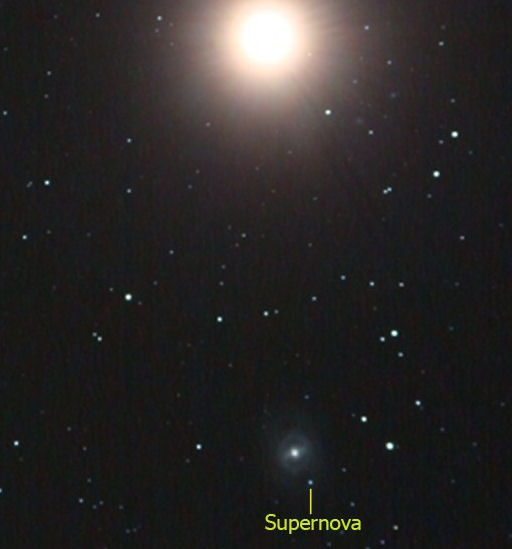FARSIDE CME: A coronal mass ejection (CME) blasted away from the farside of the sun on March 21st at 0740 UT. SOHO photographed the cloud expanding at 1550 km/s (3.5 million mph). The source of the CME is probably old sunspot AR1429, still active as it transits the farside.
FIRST AURORAS OF SPRING: It's a well-known scientific fact that equinoxes favor auroras. True to form, March 20th began with the vernal equinox and ended with this outburst of Spring-green over Tromsø, Norway:
"It was an absolutely magic moment in a magic place," says photographer Ole C. Salomonsen. "The temperature was -13 C and I was almost alone: The tracks in the snow are from a fox which was there just before me. The auroras were mostly moderate, but at times they burst into strong lightshows, as shown above. It was a beautiful display." Aurora alerts: text, phone.
more images: from Bernt Olsen of Simavika, Tromsø, Norway; from Frank Olsen of Sommarøy / Tromsø, Norway; from Arild Heitmann of Tennevik River, Troms, Norway; from B.Art Braafhart of Salla, Finnish-Lapland; from Einar Halvorsrud of Alta, Norway; from Nenne Åman of Arjeplog, northern Sweden
MARS AND THE SUPERNOVA: "On March 18th, I photographed the planet Mars among the galaxies of Leo," reports amateur astronomer Oscar Martín Mesonero of Salamanca, Spain. "The next morning, I learned that a supernova exploded in the galaxy M95. I quickly checked the photos and there it was!" (continued below)
"Unwittingly, using my ED80, I had photographed a supernova of magnitude +13.5 only two days after its discovery," says Mesonero. "I never expected the night to bring so many wonderful things."
The rapidly brightening supernova is an easy target for mid-sized backyard telescopes equipped with CCD cameras--and it's easy to find only a degree south of Mars. Astrophotographers, now is your chance to catch a supernova in the act.
more images: from Anthony Ayiomamitis of Athens, Greece; from Efrain Morales Rivera of Aguadilla, Puerto Rico; from Zlatan Merakov of Smolyan, Bulgaria; from Jeff Donaldson of Enfield, NS Canada;

![]()
Solar wind
speed: 366.8 km/sec
density: 0.3 protons/cm3
explanation | more data
Updated: Today at 1616 UT
![]()
X-ray Solar Flares
6-hr max: C2 1252 UT Mar21
24-hr: C2 1252 UT Mar21
explanation | more data
Updated: Today at: 1600 UT
![]()
![]()
![]()
Daily Sun: 21 Mar 12
![]()
![]()
All of these sunspots are quiet. No strong flares are in the offing. Credit: SDO/HMI
![]()
![]()
![]()
Sunspot number: 74
What is the sunspot number?
Updated 20 Mar 2012
Spotless Days
Current Stretch: 0 days
2012 total: 0 days (0%)
2011 total: 2 days (<1%)
2010 total: 51 days (14%)
2009 total: 260 days (71%)
Since 2004: 821 days
Typical Solar Min: 486 days
Updated 20 Mar 2012
The Radio Sun
10.7 cm flux: 100 sfu
explanation | more data
Updated 20 Mar 2012
![]()
![]()
![]()
Current Auroral Oval:
![]()
Switch to: Europe, USA, New Zealand, Antarctica
Credit: NOAA/POES
![]()
![]()
![]()
Planetary K-index
Now: Kp= 2 quiet
24-hr max: Kp= 2 quiet
explanation | more data
![]()
Interplanetary Mag. Field
Btotal: 3.6 nT
Bz: 0.3 nT north
explanation | more data
Updated: Today at 1617 UT
![]()
![]()
![]()
Coronal Holes: 21 Mar 12
![]()
![]()
There are no large coronal holes on the Earthside of the sun. Credit: SDO/AIA.






